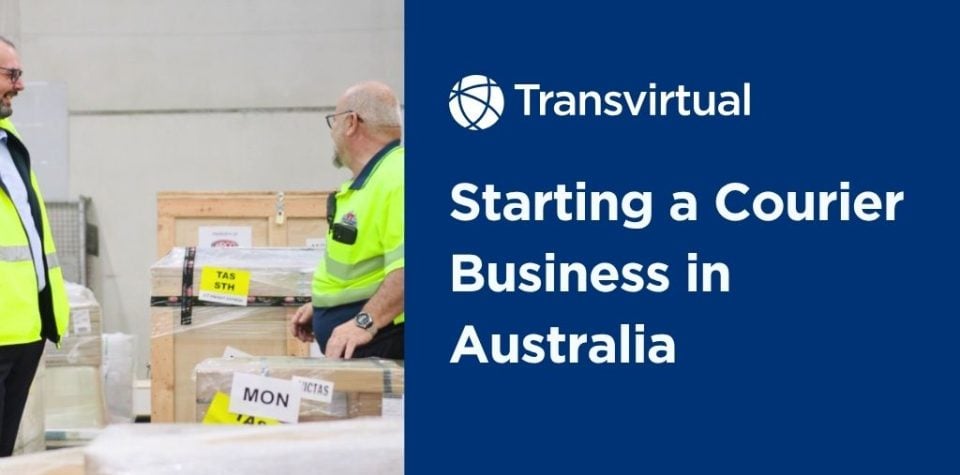Table of Contents
Starting a courier business in Australia is a huge undertaking with a lot to consider from the outset. You’ll need strategy, careful planning, and the right tools to stay competitive.
Whether you launch a solo delivery run or manage a fleet of drivers, you have to lay a solid groundwork that helps to define your long-term success. Let’s take a look at how to start a courier business in Australia.
How to Start a Courier Business in Australia: A Comprehensive Guide
A courier business delivers items like packages, documents, products, or medical supplies from one location to another. A courier company may deliver important documents, packages, and other items, requiring secure and reliable transportation. These services can be business-to-business (B2B), business-to-consumer (B2C), or directly person-to-person.
Starting a courier or courier company in Australia involves a series of key steps.
You’ll need to create a business plan. It is also important to select and register a unique company name as part of the legal registration and branding process. Then, choose your service type, and secure required licenses and permits. These elements are crucial, no matter the size of your business at the start or what you plan to evolve into in the future.
Introduction to Courier Services
The courier industry is a thriving industry, especially in a time where online shopping has become the norm. This surge in e-commerce has led to a significant increase in demand for reliable delivery services, making starting a courier business an attractive opportunity for entrepreneurs.
Whether you’re interested in operating from one location with a single vehicle or managing a team of drivers across multiple areas, the courier business offers flexibility and the potential for high returns.
To build a successful courier business, it’s essential to conduct thorough market research. Understanding your target market—whether it’s local businesses, individuals, or specialized sectors—will help you tailor your services to meet their needs. Providing excellent customer service is also crucial; satisfied customers are more likely to become repeat clients and recommend your courier service to others.
Part One – How to Start a Courier Business
Start with the basics
Begin by doing your research. Study your local market in an effort to understand the demand for courier services.
A web scraping API can help you gather competitive data from online sources. Understanding the needs of potential clients is crucial, as it allows you to tailor your new courier service to address specific gaps and stand out in the market.
Try to identify:
- Your competitors
- Gaps in the market where a new courier service could meet unmet needs
- Your pricing model
- Your budget, including vehicle and equipment costs
You’ll also need to grasp the legal landscape for how to start a transportation business in Australia. This includes transport regulations, workplace health and safety requirements, privacy laws, etc. And, don’t forget to apply for your Australian Business Number (ABN)!
Business Structure and Finance
You’ll need to decide whether to operate as a sole trader, partnership, or company, as each option affects your tax obligations, personal liability, and the way you conduct business. Registering for an Australian Business Number (ABN) is essential, and if you’re setting up a company, you’ll also need an Australian Company Number (ACN).
Opening a dedicated business bank account will help you manage your finances efficiently and keep your business and personal expenses separate. A comprehensive business plan is crucial for success—it should outline your marketing strategy, financial projections, and the services you plan to offer.
Don’t forget to factor in start-up costs, such as purchasing vehicles, equipment, and technology. Ensuring you have adequate insurance coverage, including public liability insurance, will protect your business from unexpected events and help you meet legal requirements.
Whether you’re starting a courier business as a small operation or planning to scale up, careful planning and financial management are essential.
By laying a solid foundation, you’ll be well-positioned to offer a range of courier services, from package and document delivery to specialized medical supply transport.
Setting Up Shop
Next, it’s time to start choosing a suitable business location. This could be a rented office, a commercial space, or even a spare room in your home, depending on your budget and the scale of your operations.
A courier business can operate from one location or expand to multiple sites as it grows. Offering a variety of services, such as same-day or express delivery, can help you attract a broader customer base and establish your reputation in the market. By investing in the right equipment and staff, and by understanding your target market, you’ll set your courier business up for long-term success.
Consider the costs involved in securing and equipping your workspace as well, and make sure it’s outfitted with the essential equipment and technology you’ll need—such as GPS tracking devices, mobile phones, computers, printers, scanners, label makers, and packaging materials.
Hiring the right staff is another key step. You’ll need reliable courier drivers who are well-trained and understand the importance of timely, safe deliveries.
Create a business plan
Decide on the way you want to conduct business by choosing a suitable legal structure. Are you operating a sole proprietorship or as a partnership or company? Running your own courier business gives you both the flexibility and responsibility to make key decisions, manage operations, and grow your enterprise independently.
If you’re independent, are you ready to bring on extra help during the busy holiday seasons or other peak periods? If you’re managing a team of drivers, you can consider a small business loan to manage the start-up costs like having company vehicles. It’s also crucial to open a business bank account to effectively manage your business finances and keep them separate from personal expenses. When bringing on extra help, it’s important to have comprehensive employment agreements in place to ensure legal clarity and protect both your business and your staff.
The differences between these two business setups is:
-
the volume of your deliveries
-
the amount of money you need to charge per delivery (to cover operational costs)
-
how much paperwork is required, including the necessity of obtaining a business license for legal operation in Australia.
If you’re managing a team of drivers, be sure to pay them in a way that benefits your business come tax time. This is usually fairly simple: have them register as an independent contractor. Establishing clear payment methods for both employees and contractors is essential to ensure smooth cash flow and scalability. You can stay up to date with the requirements of employees vs. contractors via the ATO. When you hire employees for your courier business, consider their qualifications, driving skills, and willingness to work flexible hours to ensure you build a reliable and effective team.
1. Will you have a niche, and if so what is it?
Perhaps the most important early question to ask yourself is: How does my courier service differ from others already in the market?
You might find more success if you pitch yourself as an industry specialist. For example, a refrigerated courier service or a food delivery service. If you’re thinking about how to start a logistics company that caters to local businesses, this is an essential step. Niche services offering same-day delivery or custom-tailored solutions can win more loyal clients. If you plan to launch your own courier company, conducting thorough market research is crucial to differentiate your business from established competitors and larger firms.
A quick note: even if you’re an independent contractor who works alone, it’s useful to outline a clear delivery process. This will help you identify bottlenecks and make improvements in your services for faster, more profitable runs.
When you’ve started a courier business and you’re looking to bring on more drivers, post your job ad on online job boards (like Indeed.com or LinkedIn).
As you already understand exactly what kind of delivery service you offer, it will be easier to write a job ad that attracts your ideal candidates.
Here are some questions to ask:
- Will you provide the delivery vehicle, or will they?
- Do they need any special kind of driver’s license?
- Do they need experience in areas other than driving (remember the medical supplies as above, for example)?
- What are their hours likely to be?
- Are they required to work nights, weekends or holidays?
- What’s the expected salary or hourly rate?
You may not have every answer yet, but the more specific you are, the better your chances of hiring drivers suited to your business.
Once hired, remember that training goes beyond maps and apps. Your drivers need to operate with a professional mindset. That means they’ll need to:
- Maintain a clean and professional appearance
- Keep their vehicles tidy and road-ready
- Handle packages with care, especially sensitive or time-critical deliveries
Strong organisational skills are also essential for managing delivery schedules, handling customer service, and ensuring all tasks are completed efficiently.
If you’d like to learn more, check out this guide we wrote on training delivery drivers.
3. Growing your client list
Learning how to start a courier business in Australia is one thing, but growing it into a thriving company is another.
Your client list dictates whether or not you see long-term success. Whether you specialize in a niche or offer general delivery services, you simply need a steady stream of recurring work. Securing repeat business is crucial for ensuring long-term profitability and building a stable client base.
If you’re in a niche, you have a strong angle when you approach new clients. Targeted services make it easier to demonstrate value and stand out from the generalists. If you are more general, you’ll need to define what sets you apart. Are you faster than other couriers in your area? Do you offer extended hours, or competitive pricing?
The ideal clients to approach include:
-
Restaurants
-
Grocery stores
-
Florists
-
Breweries
-
Pharmacies
The good news is that courier businesses tend to have pretty local runs, so you’ll probably only need to scout a limited area.
You can also try joining online forums and networks for couriers, however, these tend to be extremely competitive and can have very large numbers of couriers pitching for a single service.
Marketing and Promotion
Marketing and promotion are essential for building a successful courier business. Start by creating a strong brand identity, including a memorable business name, a professional logo, and a user-friendly website. Develop a marketing plan and allocate a budget to ensure your promotional efforts are consistent and effective.
Utilize a mix of marketing strategies to reach potential customers. Social media marketing, email campaigns, and paid advertising can help you increase visibility and attract new clients. Don’t underestimate the power of excellent customer service—satisfied customers are more likely to recommend your courier service and become repeat clients. Use SMS messages and other direct communication channels to keep customers informed about their deliveries and to promote your services.
Search engine optimization (SEO) is also crucial for making your website visible to people searching for courier services online. By focusing on providing excellent customer service and actively promoting your business, you’ll build a loyal client base and establish your courier business as a trusted provider in your area.
Part Two – Provide Successful Courier Services
Your business is set up, you’ve sorted your fleet, and have either hired drivers or are working independently. You’ve defined your specific services. When managing your fleet, consider whether to use your own vehicles or employee-owned vehicles for business operations, as this affects vehicle suitability, fleet management, and insurance requirements. Now, you need to optimise.
When it comes to running a fast-paced business, automation is your secret to success. With the help of a transport management system, you not only get to automate and organise workflows but you can also optimise your operations and achieve the goals below:
Delivery Service Options
A successful courier business offers a range of delivery service options to meet the diverse needs of its customers. These can include same-day delivery, express delivery, and standard delivery, each requiring different levels of speed and resources. To provide these services efficiently, you’ll need to invest in the right vehicles and specialist equipment, especially if you plan to handle medical equipment or hazardous materials.
Implementing a robust route planning system, ideally with route planning software, is essential for optimizing delivery routes, reducing costs, and ensuring timely deliveries.
If you plan routes manually, it can seriously eat up your hours. Real optimisation requires you to factor in:
-
Every driver’s full delivery load
-
The order and timing of stops
-
Distance and traffic conditions
-
Pickup and drop-off durations
With routing software like Transvirtual, you won’t need to handle this manually. Instead, your dispatch team (or you, if you’re a sole proprietor) can save time and drastically reduce errors on smarter, faster deliveries.
1. Route optimisation
Efficient route optimisation allows you to:
-
Deliver more packages each day
-
Reduce fuel and labour costs
-
Provide faster service for customers
If you plan routes manually, it can seriously eat up your hours. Real optimisation requires you to factor in:
-
Every driver’s full delivery load
-
The order and timing of stops
-
Distance and traffic conditions
-
Pickup and drop-off durations
With routing software like Transvirtual, you won’t need to handle this manually. Instead, your dispatch team (or you, if you’re a sole proprietor) can save time and drastically reduce errors on smarter, faster deliveries.
2. Route monitoring (or driver tracking)
When your drivers are on the road, things can change quickly. Planning the best route is only the beginning.
Driver tracking allows you to:
-
Monitor driver locations and ETAs in real-time
-
Respond rapidly to changes and delays
-
·Reassign deliveries based on who’s closest or available
If you’ve started a logistics company that manages multiple drivers and vehicles, you need this capability. Your entire operation will stay nimble and responsive, which helps you make smart decisions in the moment rather than losing countless hours due to inefficiency.
3. Order tracking
Once you start a courier business in Australia, you can save a lot of time on customer enquiries with automated receipt notifications, or order tracking.
Your customers expect total visibility. They want to know where their package is and the moment it will arrive. If you’ve ever ordered something online, you know the power of those little updates.
Automated order tracking enables you to send real-time notifications to customers when:
- The delivery run starts (with an ETA)
- The driver is nearing their stop (with a more precise window)
A software like Transvirtual makes this offering easy, through SMS, email, or both. Customers can also reply with specific instructions to give your drivers better info and reduce support calls to your business.
If you started a transportation business that focuses on customer satisfaction, this level of communication changes the game.
4. Proof of delivery
As a courier, you know deliveries can go sideways. Packages can be misplaced, dropped off at the wrong address, or even stolen. This is why you need clear, irrefutable proof that your delivery was completed correctly.
Transvirtual helps you capture proof of delivery (POD) in two ways:
-
Photographic POD: Drivers take photos of delivered items at their locations. The app stores the image with GPS data to act as proof for both you and your customers.
-
Electronic Signature: By using sign on glass technology, your customers sign directly on your drivers’ devices, with location and time data automatically logged.
POD protects you and reassures your clients by streamlining your support process. If you’re serious about accountability (and reducing headaches), it’s a must.
To recap, there are four essential factors in running a successful courier business in Australia:
1. Optimise your routes
2. Track your drivers in real-time
3. Keep your customers up-to-date
4. Collect reliable proof of delivery
Using an automated Transportation Management System (TMS) like allows you to implement all four of those steps simply and seamlessly, freeing your time up to work on your business rather than in it.
Next steps…
There’s a lot to think about when you start a courier business (things like business name, insurances, social media pages, and so on). But to make sure your new business is sustainable and profitable, you must optimise your delivery processes.
No matter your industry niche, or lack of, a successful courier business is one that can deliver goods to their final destination safely and quickly, while also making enough money to cover costs and pay everyone involved.
Using a TMS like Transvirtual means you will reduce costs while still making sure your clients (and their customers) are happy with your service.
If you’d like to learn more about how Transvirtual can help you start a courier business, get in touch today for a chat or you can book a free demo.
Become your own boss in the courier industry today!





